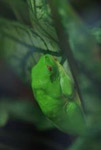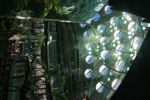Review of the indoor rainforest at San Francisco’s new Academy of Sciences
by Harry S. Pariser, special to mongabay.com
November 4, 2008
Guidebook author Harry S. Pariser evaluates the rainforest dome at San Francisco’s new Academy of Sciences
|
|
As a longtime resident of San Francisco's Inner Sunset district, I am quite familiar with the Academy of Sciences which is a short walk from my domicile. While I had visited it many times in its previous incarnation, the old (now demolished) museum was a far cry from the new high-tech building that opened this Fall. Both as someone who has traveled extensively in the tropics, and as the author of a number of travel guides which cover tropical rainforests and their ecosystems as well, I was looking forward to one of its most highly touted new features: the "rainforest dome."
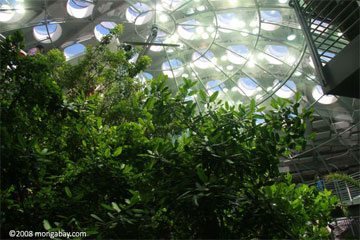 4-story rainforest in the new CA Academy of Sciences in San Francisco |
What I found disappointed me. There is no doubt that the dome is an attractive facility. It's the largest of its kind in the world – indeed its only rival, in Italy, was designed by the same Italian architect. The dome maintains temperatures of 82-85° F, and a special misting system ensures a 5% or above humidity. A spiraling ramp, leading up to the top, passes through samples of rainforest flora and fauna from Borneo, Madagascar, and Costa Rica (representing the three areas of the world with the most extant rainforest: Southeast Asia, Africa, and Central and South America). From the top one takes an elevator to the "Amazonian Flooded Forest" where an underwater tunnel traverses a 100,000-gallon tank. The pathway is visible when looking down from the top of the dome, which makes for a spectacular view. The Rainforests of the World exhibit begins with bats and scorpions and numerous chameleons from Madagascar are caged as are Costa Rica's diminutive poison dart and tree frogs. All and all, it is a beautiful exhibit.
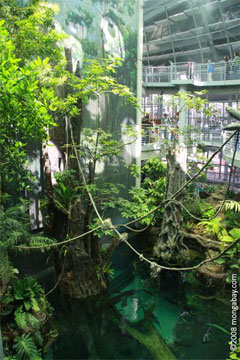 Indoor rainforest in the new CA Academy of Sciences in San Francisco |
Where I found it wanting was in terms of signage and information. While species are labeled, information is wanting. For example, while a colony of leafcutter ants is on display, I felt that information about the invertebrates could have been more informative. Similarly, I saw an owl butterfly and a blue morpho (both of which are common in Costa Rica), but I did not see identifying signage which might have told me more about these species and the reasons for their unique colorations. I thought that more information about the threats to these rainforests could have been better highlighted, along with more specific information – of the kind I might expect to find in a book or documentary about the subject. There was little information on the poison dart frogs for example, and I failed to get a real sense of the splendor of the canopy. Finally, one of the keystones to understanding the rainforest are its many symbiotic relationships, and I failed to see these detailed. Overall, however, Rainforests of the World does provide people who can not get to a rainforest or who are preparing to visit one, with a valuable introduction. Hopefully, improvements are on the way.
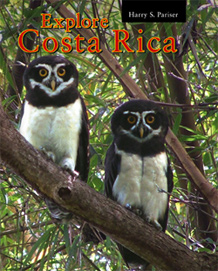 Explore Costa Rica |
Admission to the Academy is: $24.95 for adults; $19.95 for youth ages 12 to 17, Seniors ages 65+ and students with valid ID; $14.95 for children ages 7 to 11; and free for children ages 6 and younger. The Academy is free to the public on the third Wednesday of each month.
Admission fees include all exhibits and shows. Hours are 9:30 am – 5:00 pm Monday – Saturday, and 11:00 am – 5:00 pm on Sunday.
Harry S. Pariser is the author of Explore Costa Rica, a travel guide to the country.
He offers tips on visiting the rainforest here: Advice for your first visit to the rainforest: An interview with author Harry S. Pariser about rainforests
Related
Photos of the new California Academy of Sciences in San Francisco September 19, 2008
The new California Academy of Sciences in San Francisco’s Golden Park will open its doors to the general public for the first time on the weekend of September 27-28.
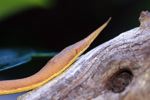


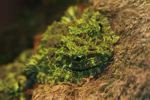
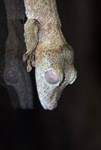
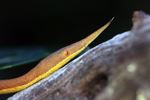
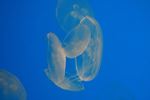


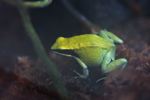
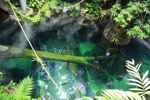
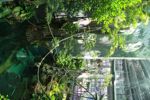
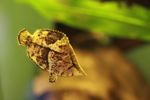
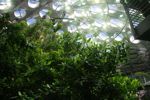
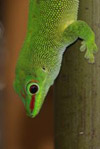
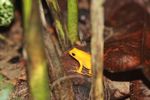
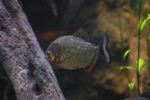
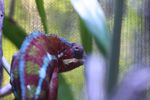
![Turquoise Honeycreeper [Dacnis cayana] eating a fruit](https://travel.mongabay.com/animals/081022/150/calacad_137.jpg)

